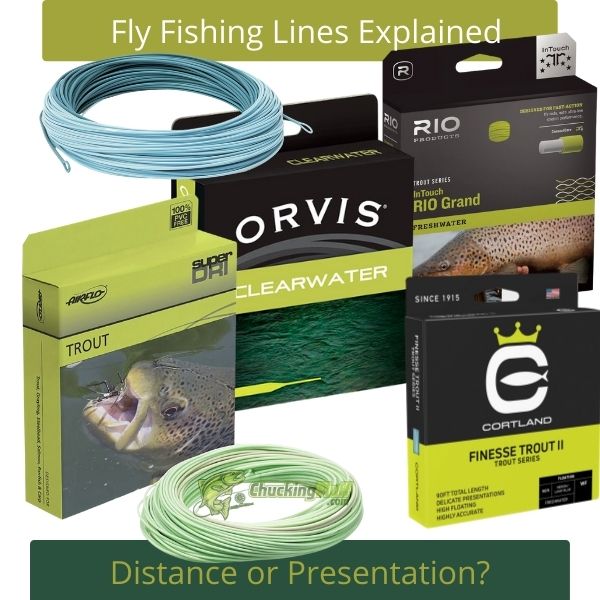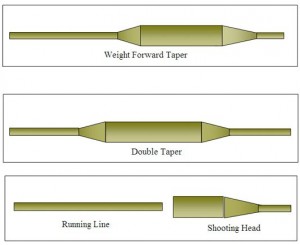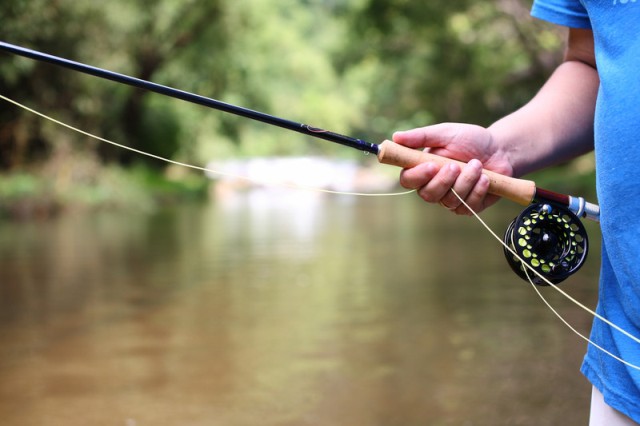| Disclosure: Just to be open and honest the buttons and links you click on in the website will in most cases take you to another website where you can purchase the products I am reviewing. As an Amazon Associate I earn from qualifying purchases. |
Fly Fishing Lines Explained – A Guide for the Beginner
The Fly Fishing Line is a lot thicker than traditional monofilament fishing line. To get your fly out into the water in an attractive gentle method takes practice and some skill.
These can be learned but the fly fishing line is critical to the cast, get it wrong and you may as well not bother fishing at all.
A bad cast will collapse and crash onto the water surface spooking any fish that are in close proximity, this is not a good thing as once spooked it’s very hard to get them back.

There are many variations of fly line however the options we will be concerned with here are weight, density, taper and color. So let’s delve deeper and get fly fishing lines explained to us.
Quick Post Navigation
Fly Fishing Line Weight
AFTM or the Association of Fishing Tackle Manufacturers came up with a standard to measure all fly fishing tackle including the line ratings.
This scale means if you buy a seven weight line from any manufacturer it will fit any seven weight rod and reel from any other manufacturers…cool right! That being said there are always exceptions to the rule but we will not concern ourselves with this now.
The line rating is worked out on the first 10 yards of line or 30ft which is about what you would use to load the rod to make a cast on the old traditional lines.
Loading the rod means flex it enough to perform a cast. Your rod needs a certain amount of weight outside the tip ring to allow it to throw a line. As the line rating number gets higher the line weight gets higher and will require a larger stiffer rod to cast it properly.
As a beginner, we have been working on the 9ft 5 AFTM rated setup.
Fly Fishing Line Density
The three main densities of fly fishing line are full floating, intermediate and sinking. There is another bag full of variations to this with floating and sink tips and intermediate and sink tips.
A whole array of sinking speeds are also available, a one inch per second slow sink to seven to nine inches per second fast sinking and a well-equipped fly fisherman will have an array of these lines with him at all times to suit the conditions as they change.
This we will leave to another post and in the interest in keeping things simple I would recommend starting with a floating line as other sinking lines require more effort to move them up through the water column in preparation to cast.
Fly Fishing Line Taper
Again there are three main tapers to fly fishing line, double taper, weight-forward taper and shooting head. Double taper is useful on small rivers for roll casting and roll casting on boats when distance is not an issue.
These are very good for accurate casting and a favorite for dry fly fishermen. Weight forward is basically the weight of the line pushed toward the front taper of the fly line meaning more weight at the front and so is easier to cast, not as accurately but still very good.
The remaining line or running line is thinner and runs easily through the rod rings making for smooth long casts.
The shooting head is the weight forward line squeezed even further to the front and in so you can load the rod very quickly and shoot the running line out through the rod rings making for very long casts.
This line would not be very accurate but in the hands of an advanced angler can be a good tool on large waterways.
Each has its merits but for the purpose of learning, I would go for a weight forward line.
Fly Fishing Line Color
Lastly, there is the color which has as many variations as there are lines and is down to personal taste however as a guide bright colors are usually floating lines where neutral colors are for intermediate and dark colors are for sinkers.
Of all the items that make up a beginner’s fly fishing kit I would recommend spending the most on the fly line depending on your budget. A decent fly line can be had for about £40-£50 or $45-$65 dollars.
There are loads of cheaper options but I would try and stay away from budget lines. Generally speaking, a better quality fly line will be supple, smooth and flow through the rod rings with ease. It will also load the rod better and form loops easier and so enhance the casting experience.
In my opinion spending, a bit more on the line will greatly assist your ease of learning how to cast. Buying a cheap line that kinks easily and doesn’t load correctly will only frustrate you and could put you off learning how to fly fish altogether.
There are some good quality budget lines available but you would need to be an average fly caster to get the use from them. If you are going to be spending most of your time on stony banks then budget lines can prove to be a good economic option as you will inevitably stand on your line as you move about causing it damage.
There are ways of avoiding this like using a line tray or using your fingers to manage the line and keep it off the ground but these are tricks and tips that you will pick up after you master the basic cast.
Some of the brands I have used and would recommend are Cortland, Airflo, Rio, Orvis and Scientific Anglers.
Conclusion
So for the beginning to learn how to fly fish, you would want a full floating weight forward number seven fly line which will be noted with the following designation WF5F. As a comparison, a double tapered six intermediate would be DTI6 or DT6I depending on the manufacturer. So there you have it fly fishing lines explained in their various states.



My boys got introduced to fishing this past summer and all learned to cast pretty well. My youngest is 7 and he got the hang of it in an hour or so.
That’s great to hear some are naturals and the sport is not really that difficult to learn it just takes a bit of practise.
That is encouraging to that I can learn new tricks. I have fished mostly using bait and wait methods, because I am out there to relax and if a fish happens by then bonus! Always saw fly fishing as too much work, but you are starting to turn the tide with your site here.
I like fly fishing as you can be on the move all the time searching out new pools and beats. However if you require a more leisurely approach boat fishing is cool. You can float about casting short lines 20-30ft without much effort. Then retrieve slowly before you cast again. Have spent many a happy evening doing exactly this.
Never fly fished before, just salt water spinning. It looks cool when they keep casting the line out and pulling it back (sorry, don’t know the correct terms) until they get it in the right spot. This is a very helpful page for us rooks:)
Charles yea the secret is to be able to cast to a rising trout in one false cast as the more you cast back and forth the more chance the trout has to see you and move away.
My sister’s 12 year old wants to learn how to fly fish and wants the reel for Christmas. do you think 11 is too young to learn? It’s expensive to buy the equipment if he’s not going to be able to actually do it. Do you recommend a certain kind for beginners? (less expensive the better)
thanks. Great info here; even non fisherwomen understand/
Hi Lisa you can learn at any age as long as the rod is light enough for the individual. I would recommend a kit for a newbie,
here is a Airflo Fly Fishing Kit that Fistec do that is respected as a good starter kit. Thanks for your commments!
Great information here Mark, was looking for an additional good line to put on my 6 weight 9ft rod which I use on a small river for trout. The flow is fairly quick but not really that deep. I already have a full floater from Cortland but wanted to get one to sink. Do you think an intermediate of full sinker would be better?
Hi James, if the river is fairly fast then the intermediate will not get down quick enough, you will probably see it drop when it comes around on the dangle. However to get down quicker you will need to get a medium to fast sinker. You say not really that deep if we are talking 3-5ft then a medium would be OK depending on water speed.
If water speed is fast then go faster sink rate. If is’t 6ft plus deep then fast sink would be a better bet.
Hope this helps. If you want to come back with more detail I will give you my thoughts. i.e. how fast the flow feet/second and how deep in feet.
Thanks for stopping by. Tight lines!
I was wondering how much it might cost to get a basic set of starter gear. I have never been fly fishing but your site has me wanting to learn.
Do you have some recommended starter gear, the truth is I have no clue where to start.
Hi Ty, a basic starter kit can be got for around £50-£100 the more you spend the better quality the kit. Here is a Airflo Fly Fishing Kit that Fistec do. There’s a small video clip on there too giving you a bit more detail of the product. I have never been disappointed with Airflo and with that saving of £40 its got to be a bargain.
If you want to spend a bit more you can pick and choose the setup using different brands. It would also help if I knew what type of fishing you would be doing, lake, river, trout, salmon, pike, perch etc etc. What fishing is in your local area? I would also visit your local tackle store for advice on what techniques work and also the licensing laws before you commit.
Any more advice let me know and I will do what I can to assist.
Well I am not really sure, when I get back to the states I will have to see what’s available in my area. I didn’t even realize all of these were an option. I will get back to you on this when I get some information put together.